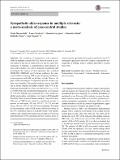Files in this item
Sympathetic skin response in multiple sclerosis : a meta-analysis of case-control studies
Item metadata
| dc.contributor.author | Margaritella, Nicolò | |
| dc.contributor.author | Mendozzi, Laura | |
| dc.contributor.author | Garegnani, Massimo | |
| dc.contributor.author | Gilardi, Elisabetta | |
| dc.contributor.author | Nemni, Raffaello | |
| dc.contributor.author | Pugnetti, Luigi | |
| dc.date.accessioned | 2022-03-15T15:30:01Z | |
| dc.date.available | 2022-03-15T15:30:01Z | |
| dc.date.issued | 2018-01 | |
| dc.identifier | 278278743 | |
| dc.identifier | 1ef1fd36-f950-42cc-877e-e1f2c8599faa | |
| dc.identifier | 28963666 | |
| dc.identifier | 85030180351 | |
| dc.identifier.citation | Margaritella , N , Mendozzi , L , Garegnani , M , Gilardi , E , Nemni , R & Pugnetti , L 2018 , ' Sympathetic skin response in multiple sclerosis : a meta-analysis of case-control studies ' , Neurological Sciences , vol. 39 , no. 1 , pp. 45-52 . https://doi.org/10.1007/s10072-017-3111-6 | en |
| dc.identifier.issn | 1590-1874 | |
| dc.identifier.other | PubMedCentral: PMC5772132 | |
| dc.identifier.uri | https://hdl.handle.net/10023/25050 | |
| dc.description | The study was supported by a grant of the Italian Ministry of Health, Ricerca Corrente funding program 2014–2015 [RC2014]. | en |
| dc.description.abstract | The usefulness of sympathetic skin responses (SSR) in multiple sclerosis (MS) has been advocated by several studies in the last 20 years; however, due to a great heterogeneity of findings, a comprehensive meta-analysis of case-control studies is in order to pinpoint consistencies and investigate the causes of discrepancies. We searched MEDLINE, EMBASE and Cochrane databases for case-control studies comparing SSR absence frequency and latency between patients with MS and healthy controls. Thirteen eligible studies including 415 MS patients and 331 healthy controls were identified. The pooled analysis showed that SSR can be always obtained in healthy controls while 34% of patients had absent SSRs in at least one limb (95% CI 22-47%; p < 0.0001) but with considerable heterogeneity across studies (I2 = 90.3%). Patients' age explained 22% of the overall variability and positive correlations were found with Expanded Disability Status Scale and disease duration. The pooled mean difference of SSR latency showed a significant increase in patients on both upper (193 ms; 95% CI 120-270 ms) and lower (350 ms; 95% CI 190-510 ms) extremities. We tested the discriminatory value of SSR latency thresholds defined as the 95% confidence interval (CI) upper bound of the healthy controls, and validated the results on a new dataset. The lower limb threshold of 1.964 s produces the best results in terms of sensitivity 0.86, specificity 0.67, positive predicted value 0.75 and negative predicted value 0.80. Despite a considerable heterogeneity of findings, there is evidence that SSR is a useful tool in MS. | |
| dc.format.extent | 8 | |
| dc.format.extent | 778773 | |
| dc.language.iso | eng | |
| dc.relation.ispartof | Neurological Sciences | en |
| dc.subject | Case-control studies | en |
| dc.subject | Electric stimulation | en |
| dc.subject | Galvanic skin response | en |
| dc.subject | Humans | en |
| dc.subject | Lower extremity/physiopathology | en |
| dc.subject | Multiple sclerosis/diagnosis | en |
| dc.subject | Sympathetic nervous system/physiopathology | en |
| dc.subject | Upper extremity/physiopathology | en |
| dc.subject | QA Mathematics | en |
| dc.subject | RC0321 Neuroscience. Biological psychiatry. Neuropsychiatry | en |
| dc.subject | ZA4050 Electronic information resources | en |
| dc.subject.lcc | QA | en |
| dc.subject.lcc | RC0321 | en |
| dc.subject.lcc | ZA4050 | en |
| dc.title | Sympathetic skin response in multiple sclerosis : a meta-analysis of case-control studies | en |
| dc.type | Journal item | en |
| dc.contributor.institution | University of St Andrews. Statistics | en |
| dc.identifier.doi | 10.1007/s10072-017-3111-6 | |
| dc.description.status | Peer reviewed | en |
This item appears in the following Collection(s)
Items in the St Andrews Research Repository are protected by copyright, with all rights reserved, unless otherwise indicated.

